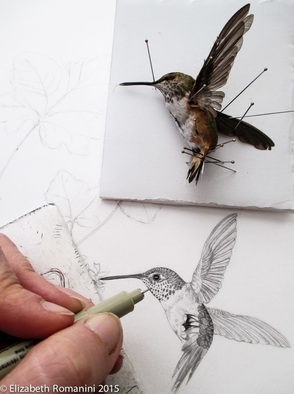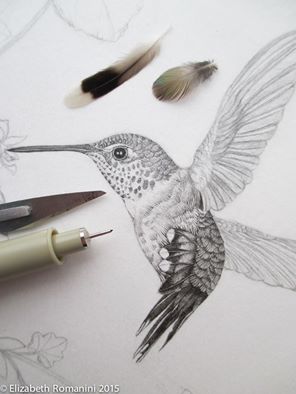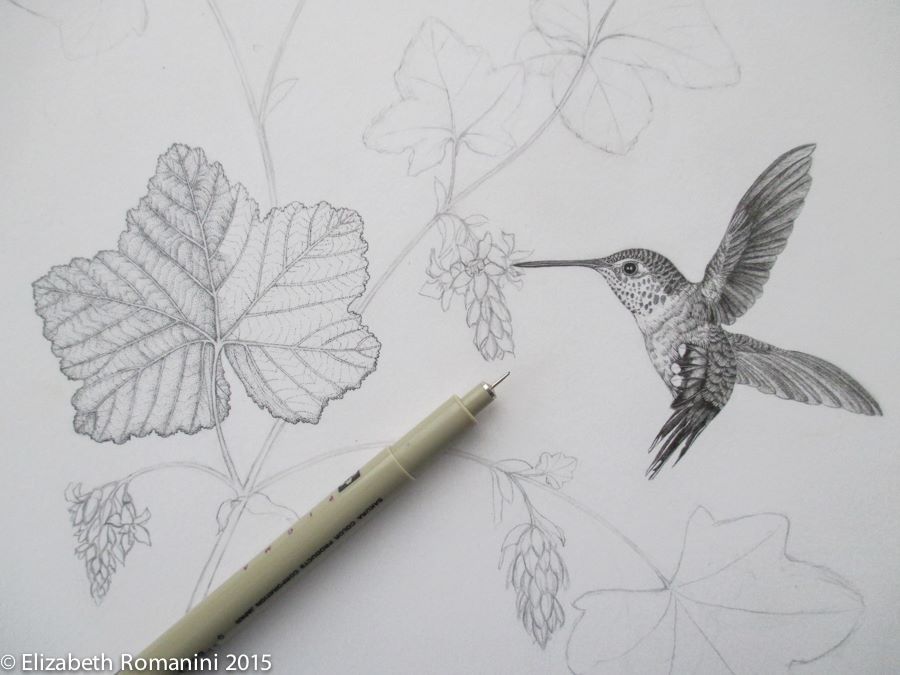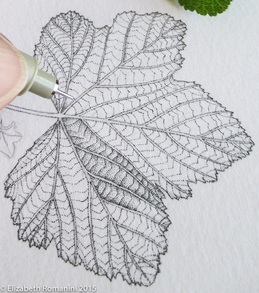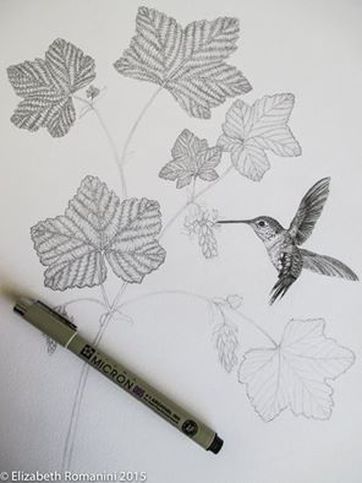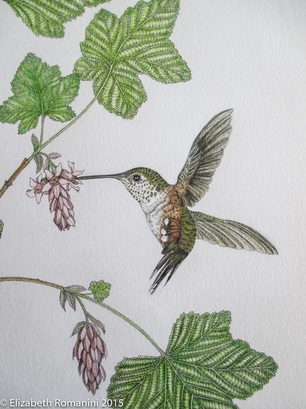| This hummingbird is something I had started last spring for my own pleasure, but had to keep setting aside for other work. It is being inked with a Pigma Micron pen that has been modified by me with a scalpel. By cutting the pen tip down I am able to do very thin line work on wee birds such as this hummer specimen. I typically do a very detailed pencil sketch first, so I know precisely where the ink will go and avoid any uncertainty about the placement. Ink can be a rigid medium to work in and mistakes can be difficult to repair, so by doing the sketch in pencil first I gain confidence in how the piece might look finished. The ink goes right over the pencil and there is usually no need to erase, as the ink completely covers it. |
| This is another work in progress shot of the little hummingbird I have been detailing in ink. The Pigma Micron pen used is .20mm, the smallest size they have available- but yet I have cut away about half the tip with a scalpel to create even thinner lines. Working with these pens once they have been altered can take a bit of practice, as well as a steady hand to account for the loss of the pens tip strength from being cut. In my experience the tip will now act almost as a paintbrush, which makes the pressure you use all the more important in maintaining even line-work. At some point I will cut the pen down again to allow for even finer detailing and shading that will in turn create more depth to the piece. When working with ink, particularly when drawing birds, you must be very aware that you are not making the feathers appear as if they are armor affixed to the birds body, but rather light and free-moving, as is their nature! |
| I have begun adding ink to one of the hummingbird wings and thought I would give you an update on the progress. I am continuing to use a pen that has been modified with a scalpel, to create very fine lines; and certainly a scalpel will be more effectively accurate in cutting the tip than a razor blade. By being able to make such fine line-work it will leave enough space to then later allow for the addition of translucent watercolour to the piece. When using specimens to work from, particularly if the have been dried and not persevered through the process of taxidermy, you must account for the shape and structure being distorted and the retraction of the wings. To create realistic subjects I spend many hours observing them in their natural habitats, because this is truly the best way to understand how creatures move and then translate that onto the paper. |
| I have finished the back wing on the hummingbird, managing thus far to have only used one pen in the process, just cutting away a bit of the tip three separate times to create finer detail. This is why I have suggested using a scalpel as opposed to a razor blade, finding that they provide the necessary precision to make a clean cut and still allow the ink to flow. You will find it useful to keep a of scrape paper, of the same kind you are using for the finished piece, to occasionally test that the ink flow is remaining consistent. Now that I have found some Flowering Currant(ribes sanguineum) blooming in the woods near my home I can begin to work on the foliage again. This will be done in a technique called stippling(making dots)and best suited for this particular plant structure. It is a slow process, but one I enjoy, as it has a very meditative quality for the mind and body. |
| In studio today continuing to work on the foliage of the Flowering Currant(ribes sanguineum) that accompanies the hummingbird from previous posts. You can see how wonderfully the stippling technique in ink can represent the lovely structure and pattern of the leaf. I really do find joy in this work, particularly when I have such an amazing and complex subject such as this plant. I find the need to restrain myself from adding to much detail, and in this case manage to accomplish that by allowing light to create harsh shadowing from which to draw from. This will be important, considering that later I will be adding translucent watercolour, which will add another level of detail to the piece. |
| I had a bit of garden harvesting to do, as we have had a spell of very warm weather here on the Central Coast of California that ripened many vegetables. Managed to get a bit of stippling work done in studio on the Flowering Currant(ribes sanguineum) leaves, when it just became too hot to work outside anymore. As you can see I am letting the leaf be back-lit by natural light to increase the visibility of the veining. By doing this I can create a pattern of movement, which will keep the leaf from appearing static and lifeless. This effect will later be enhanced with the use of translucent watercolour. |
| I have finished the second Flowering Currant(ribes sanguineum) leaf and started in on the third, beginning with stippling of the veining. You may notice with the two finished leaves that the top one is darker, this was done to distinguish between the larger leaf being seen from the underside and the smaller from the top. To accomplish this I am using more than one pen for this piece, each being modified to create different size dot. The effect will be enhanced more with the use of translucent watercolour. This is slow process indeed, but honestly I enjoy it for the meditative quality of the work. |
| Finished stippling more leaves on the Flowering Currant(ribes sanguineum) today, with just few more to do and then on to inking the flowers. I am going to have to cut down the tip of the pen a bit more with a scalpel to create the delicate structure of the petals, that may also require some line work as well. The melding of stippling with line-work can be tricky, as I prefer it to have a seamless transition, which for me is an ever evolving improvement of technique. |
| I have finally completed inking this piece of a female Allen's hummingbird(selasphorus sasin) and Flowering Currant(ribes sanguineum). My intention had been to switch to line-work for the branching structure and flowers, but I changed my mind and continued on in stippling- not sure why it just felt right! I will now be adding translucent watercolour, which will intensify the detail of the ink and allow for subtle changes of light in the texture of the leaves. Since you folks seemed to enjoy the last little video of the inking process I will make another of me painting a bit. |
